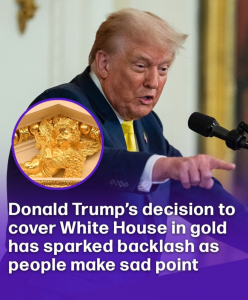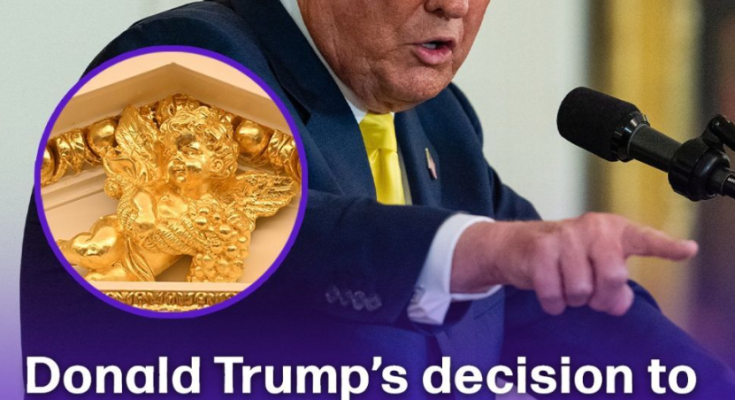Part I: The Gold-Plated Overhaul
Since returning to the White House this term, President Trump has embarked on an audacious redesign marked by opulence. Gold medallions, vermeil figurines, gilded Rococo mirrors, cherub accents, eagle statuettes, coasters, even remote controls swathed in gilt now adorn the Oval Office. These additions are clearly inspired by the luxurious décor of his Mar-a-Lago estate
Historic gilded decorative pieces—such as dessert stands, vases, and a fruit-basket—once reserved for display during tours, have been repositioned on the mantle. Notably, none of these items were made in the U.S., lending an ironic twist to an administration pushing protectionist trade policies
More recently, Trump proposed adding gold leaf to the molding of the Oval Office in the midst of a cabinet meeting—apparently treating aesthetic matters as casually as economic policy—prompting derision from both officials and the public
Beyond the Oval, the White House Rose Garden has been paved over in white stone, reportedly because “women’s heels were sinking into the grass” —a choice that commentators saw as trivializing serious spaces Plans for a $200 million ballroom modeled after Versailles’ Hall of Mirrors are also underway
Part II: The Outrage, and a “Sad Point”
Critics exploded across social media and op-eds—and it’s not just about bad taste.
1. Outrage Over Misplaced Priorities
Many pointed out the stark contrast between the extravagant spending and cuts elsewhere. One X user wrote:
“Trump is gold plating everything in the White House while cutting cancer research and meals on wheels.”
Another added:
“How do you justify covering the White House in gold after you cut cancer research funding and SNAP benefits for poor, hungry children?”
The cuts are not trivial. The administration’s so-called “big beautiful” reconciliation package includes some of the most severe reductions to SNAP benefits since 1939—impacting over 22 million families
One critic encapsulated the frustration with this pointed commentary on X:
“This is F—king real. They are throwing kids off of school meals and Medicaid and putting real gold all over the White House as if Saddam Hussein was president.”
2. Mockery of Excess
Calling the redesigns “tacky,” “gaudy,” and even a “gilded rococo hellscape,” commentators—design critics and internet users alike—suggest Trump’s version of grandeur feels more clownish than presidential
Comparison photos of the past and present Oval Office only intensified reactions:
“Pimp My White House move,” “Absolutely embarrassing,” “The Oval Office, then and now”—social media had a field day
3. Symbol of Power Misused
Experts warn that the White House’s authority derives from its understated gravitas—dignity, not decor. Media critic Robin Givhan reflected that the excessive ornamentation might undermine the institution’s symbolic power:
“Authority came from the people and from democracy,” not gold trifles
Analysts also flagged irony in how the administration elects gilded symbols of power over arts, culture, and public welfare—eschewing genuine patronage in favor of flamboyant decoration
4. A Stark Symbol of Inequality
One observer from Century Homes put it starkly: the White House now shines with more gold than even the Federal Reserve’s vault—an emblem of wealth disparity at a time of widening economic hardship. Critics see it as a microcosm of modern America where elites flourish while ordinary people struggle
The “Sad Point” in Summary
-
It reveals skewed priorities—precious tax dollars and political capital are being used to gild rooms, even as hunger, health, and social needs are being slashed.
-
It speaks to a national aesthetic crisis, where the line between grandeur and grotesque is blurred, and symbolism is amplified over substance.
-
It exposes a democracy in tension, where the seat of power risks being reduced to an image of inherited royalty rather than a beacon of accountability and civic purpose.
-
It amplifies inequality, literally turning a house of government into a palace of privilege—reinforcing, rather than challenging, social divides.
Final Thoughts
Below the glittering surface of this controversy lies something far more concerning than décor gone haywire: a disconnect between symbolic display and democratic values. What should be a modest symbol of civic unity has been gilded into a sort of private fantasy—raising a “sad point” indeed: wealth and spectacle are being placed above service and solidarity.
Would you like help exploring how other countries handle presidential decor—or reflections on how public buildings can inspire unity rather than alienation


